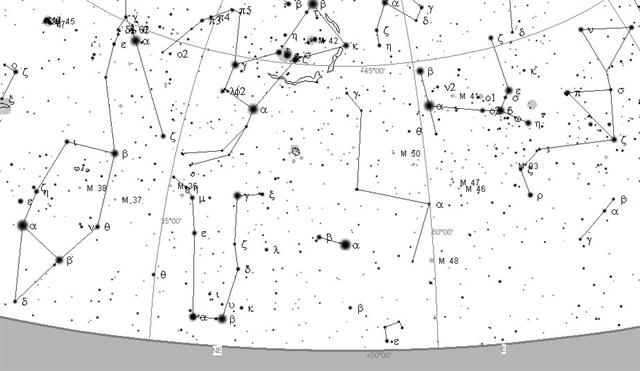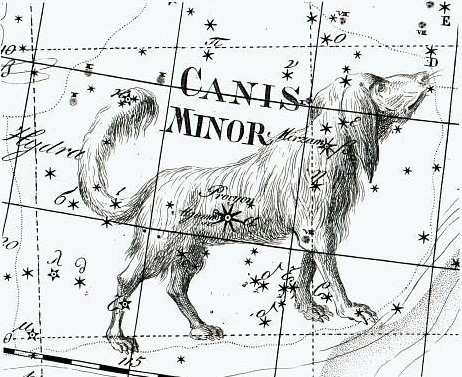By unhinging the leap day from its proper
place between Castor and Pollux the door was left open for
other 'improvements'. The old 'Gate in Gemini' through which
spirits could come and go had been closed.
My
picture above illustrates at top center Orion and below the
central hollow between the Twins. At the bottom of this hole
α (Castor) is
at left and Pollux (β) at right. The 'door' between one side
and the other, at Procyon (α Canis Minoris), has
evidently been uplifted
and moved to the right.
The view is from south of the
equator and looking towards the rising stars in the east. Maybe the explorers of the
Middle Ages had become aware of how the sky looked 'down
under' and perhaps the following discussions lead to moving the
'terminalia' 5 days ahead, from February 23 to February
28.
How could order
be restored? Perhaps those who on Easter Island still saw
the movement of spirits as a necessary ingredient in the
cosmic order developed a year with 368 days, beginning at
January 3. As a consequence their 'February 23' would arrive
2 days later than if the year had begun with January 1.
In C the
structure indicates the leap day 'door' could have been moved
to the end of the extraordinary long manzil Saad Al
Thabib, where a pair of 'coconut trees' (niu)
could be illustrating the change from below (before) to
above (after):
|
Saad Al Thabib 11 |
12 |
13 |
|
|
February 21 |
22
(53) |
23
(Terminalia) |
 |
 |
 |
|
Ca12-21 |
Ca12-22 |
Ca12-23 (339) |
|
te niu ku hakatu ua |
te maitaki - kupega tuku hia mai |
mata hakatuu |
|
λ
Piscis Austrini (336.8),
ε Cephei (337.2), Ancha (337.4) |
ρ
Aquarii (338.2) |
Sadachbia (338.6), π Aquarii (339.5) |
Castor (419) |
|
August 23 |
24
(236) |
25 |
|
An
Nathra 7 |
8 |
9
(101) |
|
Simiram, Adhafera,
Tania Borealis (154.7), Algieba,
q Carinae (155.5) |
Tania Australis
(156.0) |
μ
Hydrae (157.1) |
|
14 |
15
(285) |
|
Saad Balaa 1 |
2 |
|
24
(Bissextum) |
25 (421) |
26 (422) |
27 (58) |
 |
 |
 |
 |
|
Ca12-24 |
Ca12-25 |
Ca12-26 |
Ca12-27 |
|
te vae paupau |
te niu tutuu |
oho te rima o te niu |
a hagahaga |
|
ρ
Cephei (340.2), ζ Aquarii (340.4), Alrediph
(340.5) |
σ
Aquarii (340.9), Homan,
β Piscis Austrini (341.2) |
υ Aquarii (341.9), η Aquarii (342.1) |
Situla (342.7), ε Piscis Austrini (343.5) |
Procyon (420) |
Pollux (421) |
Azmidiske (422) |
|
26 |
27 |
August 28 (240) |
29 |
|
10 |
11 |
An Nathra 12 |
13 (105) |
|
no star listed |
Shir (158.9),
p Carinae (159.3) |
φ Hydrae (160.3) |
no star listed |
Azmidiske is ξ
Puppis and the little 'dog' - ρ - at the stern of Argo Navis
(where the rudder should be) has Azmidiske at his back side,
κ (Markab Puppis) in the center, and some for me unknown star in
front:
Canis Major is
at left and instead of a gap between Castor and Pollux we
can imagine a gap between the Vela part and the Carina part.
The ruling part, where the Ship
has her pilot must be Canopus (α Carinae).
Looking for ρ Puppis in my star list I cannot find it. Looking
again in Wikipedia it is easy to find it and its name there
is Tureis. But in my star list Tureis is the name for ι
Carinae, in Hevelius' picture where the 'double wedge' is
forcing itself into the Tree.
|
Azmidiske |
07h 49m 17.66s |
07h 49.294m |
118.4 |
|
ρ |
08h 07m 32.70s |
08h 07.545m |
123.0 |
|
Naos |
ζ Puppis |
2.21 |
39° 52′ S |
08h 02m |
122.3 |
| |
ρ Puppis |
2.83 |
24° 18′ S |
08h 05m |
123.0 |
|
Heap of Fuel |
μ Cancri |
5.30 |
21° 35′ N |
08h 05m |
123.1 |
|
Regor |
γ Velorum |
1.75 |
47° 20′ S |
08h 07m |
123.7 |
|
Tegmine |
ζ Cancri |
4.67 |
17° 39′ N |
08h 10m |
124.3 |
|
Al Tarf |
β Cancri |
3.53 |
09° 11′ N |
08h 14m |
125.3 |
|
Bright Fire |
λ Cancri |
5.92 |
24° 01′ N |
08h 18m |
126.4 |
|
Avior |
ε Carinae |
1.86 |
59º 31' S |
08h 20m |
127.4 |
|
Heka 13 |
Alhena 1 |
2 (68) |
3 |
|
July 21 |
22 |
23 (204) |
24 |
 |
 |
 |
 |
|
Ca5-17 (122) |
Ca5-18 |
Ca5-19 |
Ca5-20 (125) |
|
hakahagana te honu |
tagata moe hakarava hia |
ka moe |
hakapekaga mai |
|
8h (121.7) |
Regor (122.7),
Tegmine (123.3) |
Al Tarf (124.3) |
Bright Fire (125.4) |
|
ρ Puppis (122.0),
Heap of Fuel (122.1) |
Earlier I had Regor (one of the
stars with a reversed name) at 123.7 and Ca5-19,
but now I have corrected its position to Ca5-18
and 122.7, but I will not change what has been
written earlier.
The Milky Way goes right through
the Sunken Ship (Argo Navis) and when time is
important the horizontal direction (right
ascension) has the Rudder of the ancient ship as
its 'hinge'. The picture of Hevelius has managed
to put Canopus far down at the Rudder although
it rose in June 25. But at the top end is
ρ (the 'head'
letter, originating from the picture of a head).
122 = 2 * 61 = 8h.
There once were 'Gates' of
Cancer and this plural means there possibly was
not only one determined by the culminations of
Castor, Procyon, and Pollux, but also another one
at the heliacal gate of the same stars. Indeed
we have earlier found this speicial day could have
had number
193:
|
Antares at the time of G |
|
Rising in the east at sunset |
June 1 (152) |
0 |
0 |
|
15 days from winter solstice |
July 6 (187) |
35 |
35 |
|
Culmination at midnight |
July 11 (192) |
5 |
40 |
|
'Leap day' |
July
12 (193) |
1 |
41 |
|
Heliacal rising |
November 25 (329) |
136 |
177 |
|
Nakshatra day |
May 28 (148) |
184 |
361 |
|
Culmination at midnight |
July 11 (192) |
44 |
405 |
|
Heka 1 |
2 |
3 |
4 (57) |
|
July 9 |
10 |
11 |
12 (193) |
 |
 |
 |
 |
|
Ca5-5 |
Ca5-6 (111) |
Ca5-7 |
Ca5-8 |
|
kua iri i te rakau |
ihe tamaiti |
erua mago |
|
Wasat (109.8) |
Aludra (111.1) |
Gomeisa (111.6), ρ Gemini (112.1) |
Castor (113.4) |
|
Heka 5 |
6 (59) |
|
7 |
8 |
|
July 13 |
14 |
15 (196) |
16 |
 |
 |
 |
 |
|
Ca5-9 |
Ca5-10 |
Ca5-11
(116) |
Ca5-12 |
|
te hokohuki erua |
te marama |
te maitaki |
|
no star listed |
Markab Puppis (114.7), Procyon
(114.9) |
σ Gemini (115.7),
Pollux (116.2) |
Azmidiske (117.4) |
|
Heka 9 |
(63) |
11 |
12 |
|
July 17 |
18 |
19 |
20 (201) |
 |
 |
 |
 |
|
Ca5-13 |
Ca5-14 |
Ca5-15 (120) |
Ca5-16 |
|
te henua |
kua haga te
mea ke |
manu puoko i
tona ahi |
kua heu te
huki |
|
no stars listed |
Drus (119.9) |
Naos (121.3) |
It now appears that
there could have been a 2-day gap
between the 'shells' in July (te
hokohuki erua), one ruled by
κ Puppis
and one by Procyon, 2 nights for the
doors to swing to and fro (hoko).
|
Hoko
1. To
jump; to rock or
swing in rhythm with the
chants in festivals, as was
the ancient custom; an
ancient
dance. 2. Number prefix: 'in a group of...': hokotahi,
alone; hokorua, in a
group of two (also
companion, e hakarere te
kai mo toou hokorua,
leave some food for my
companion); hakatoru,
in a group of three, etc.;
hokohía, in a group
of how many? Hokohía ana
oho koe ki te rano? With
how many people will you go
to the volcano? Vanaga.
1. To
traffic, to trade, to buy,
to ransom (hoò);
hoòa te kaiga, to buy
land. 2. To sport, to play.
Churchill.
Move the
body to and fro with the
rythm of a song. Barthel. |
|
Huki
1. Pole
attached to the poop from
which the fishing-net
is suspended: huki kupega.
2. Digging stick. 3. To
set vertically, to
stand (vt.). 4. Huki á te
mahina, said of the new
moon when both its horns
have become visible. Vanaga.
1. To post
up, to publish. 2. To cut
the throat (uki).
Mq.: Small sticks which
close up the ridge of a
house. Ha.: hui, the
small uniting sticks in a
thatched house. Churchill.
Standing
upright. Barthel.
M. Spit
for roasting. Te Huki,
a constellation. Makemson.
Hukihuki. 1. Colic. 2.
To transpierce, a pricking.
3. To sink to the bottom.
Churchill. |
|






.jpg)





